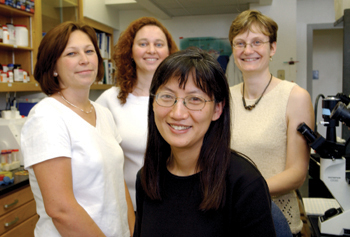
Jin Chen, M.D., Ph.D., assistant professor of Medicine, Cancer Biology, and Cell and Developmental Biology, foreground, led a study identifying a new factor that controls the formation of new blood vessels. Her research team included, left to right, Donna Hicks, Chen lab manager; Dana Brantley-Sieders, Ph.D., research instructor in the Chen lab; and collaborator Ambra Pozzi, Ph.D., assistant professor of Medicine and Cancer Biology. Photo by Dana Johnson
Receptor possibly a roadblock for tumor blood vessel formation
Like an interstate highway system, blood vessels meander through our bodies, carrying nourishment to all of our tissues.
New blood vessels must be made periodically to keep us healthy, to allow us to grow and to help our tissues recover after injury.
But sometimes this process can go awry. Too much vessel formation supports a number of diseases, including cancer, inflammatory arthritis, blindness and obesity. Too little vessel formation is linked to stroke, damage to heart muscle after a heart attack and baldness.
A new study led by Jin Chen, M.D., Ph.D., assistant professor of Medicine, Cancer Biology and Cell and Developmental Biology, identifies a potential new target for controlling angiogenesis, the process of blood vessel formation, with important implications for many such diseases.
Angiogenesis is a complex process with many controlling factors. Recently, a new family of receptor tyrosine kinases, the Eph receptors, has emerged as a key regulator of vessel formation in the embryo and in adults.
“The Eph family is the largest family of receptor tyrosine kinases. They were well-studied in terms of neurodevelopment, but in terms of their function in adult tissue, no one really knew when we began our research,” Chen said.
Chen began studying this receptor family as a postdoctoral fellow. Research in the mid-’90s, showing that this family might be involved in angiogenesis in the adult cornea, gave her the idea that this family might be involved in angiogenesis in adults.
“My lab has been mainly focused on cancer,” Chen said. Since tumors require the formation of new blood vessels in order to thrive, blocking this process would be a potential way to kill a tumor, she explained.
It is believed that tumor cells make chemicals (ephrins) that bind to the Eph receptor on endothelial cells — the cells that make up the blood vessel wall. This interaction entices the endothelial cells to migrate toward the tumor and assemble into vessels.
Chen wanted to devise a way to obstruct this interaction — erecting a molecular “roadblock” to blood vessel formation.
“The idea was that we can block the whole class of receptors and see if there was any effect on angiogenesis,” Chen said.
A few years ago, Chen used a soluble form of the EphA receptor to try and stop the interaction. Instead of being anchored on the cell surface as Eph receptors normally are, this compound freely floats in the extracellular space, waiting to bind ephrins.
These free receptors compete with the natural Eph receptors on endothelial cells, preventing them from binding ephrins and interacting with the tumor cell. This would potentially stop endothelial cell migration and halt tumor growth.
Chen’s idea worked as she expected. Over the past two years, her lab has shown that this compound inhibits endothelial cell migration, tumor angiogenesis and tumor progression. Several other laboratories have since confirmed their findings.
However, since the EphA class of receptors is so large, it wasn’t clear which specific receptor was mainly responsible for these effects.
The new study, appearing in a recent edition of the Journal of Cell Science, singles out a particular member of this family, the EphA2 receptor, as an essential regulator of blood vessel formation in adults.
“This is important clinically,” Chen said. “If you want to choose EphA class as a target (for cancer therapy), it would be more desirable to inhibit one particular receptor. You would have fewer side effects than if you were inhibiting the whole family.”
Chen and colleagues found that mice that were genetically engineered to lack the EphA2 receptor showed less angiogenesis than normal mice. Also, cells taken from these EphA2-deficient mice failed to migrate and assemble themselves into tube-like structures, a required step in new blood vessel formation.
In addition, the study determined the intracellular signaling pathway involved in EphA2’s effects. The findings pointed to a pathway known to be involved in cell migration, confirming what Chen found with the other studies.
“In this paper, we only showed that EphA2 is important in angiogenesis, but we haven’t fully determined its role in tumor angiogenesis,” Chen said.
Chen’s next step is to transplant tumors into animals that lack EphA2 receptors to see whether there are any defects in tumor blood vessel formation.
Since there are many disorders associated with abnormal angiogenesis, therapies that target EphA2 might someday be used to fight everything from balding and obesity to cancer.
This research is exciting, according to Chen, because it provides an opportunity to have a single molecule as a drug target for several different diseases.
Dana Brantley-Sieders, Ph.D., a postdoctoral fellow in Chen’s lab, was the primary author on the paper.
Co-authors of the study included Donna Hicks of the division of Rheumatology and Immunology; Ambra Pozzi, Ph.D., of the division of Nephrology, department of Medicine and Cancer Biology, and the Vanderbilt Ingram Cancer Center; Joseph Ruiz, Ph.D., of the department of Pediatrics at Indiana University School of Medicine in Indianapolis; and Justin Caughron of the department of Chemistry at Maryville College, Maryville, Tenn. Grants from the National Institutes of Health, Juvenile Diabetes Foundation, Department of Defense, American Cancer Society, Riley’s Children Foundation, and the American Heart Association supported the research.













